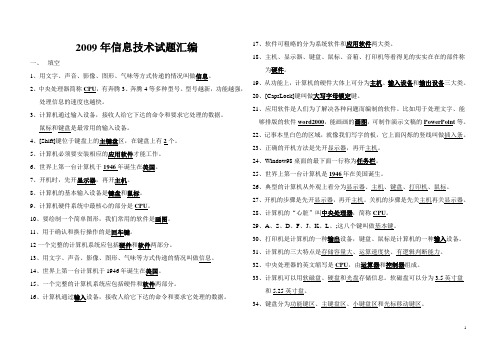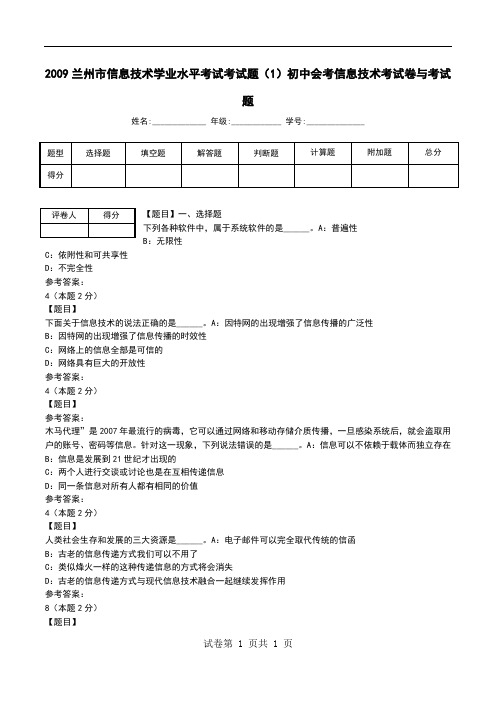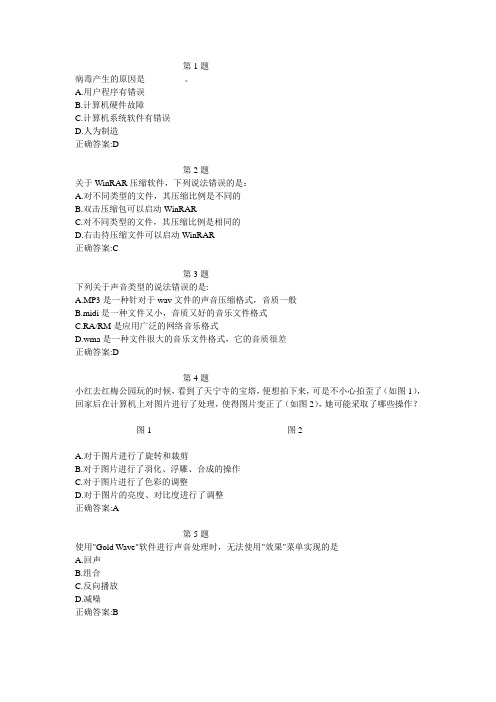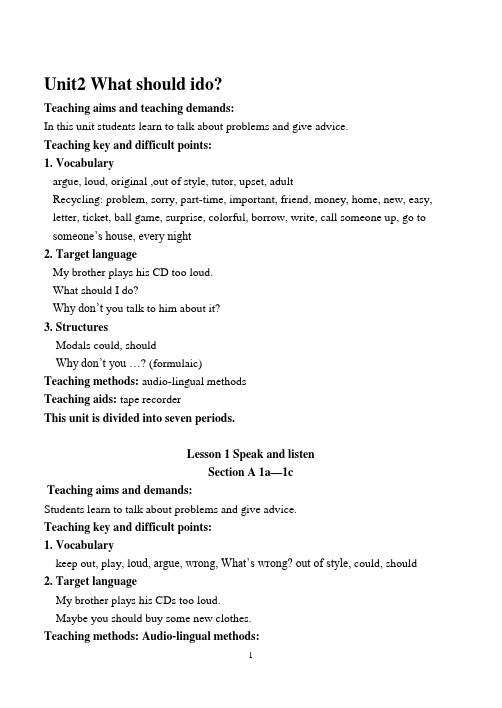信息技术——2009年中考客观题
- 格式:doc
- 大小:1.74 MB
- 文档页数:92

2009年信息技术试题汇编一、填空1、用文字、声音、影像、图形、气味等方式传递的情况叫做信息。
2、中央处理器简称CPU,有奔腾3、奔腾4等多种型号。
型号越新,功能越强,处理信息的速度也越快。
3、计算机通过输入设备,接收人给它下达的命令和要求它处理的数据。
鼠标和键盘是最常用的输入设备。
4、[Shift]键位于键盘上的主键盘区,在键盘上有2个。
5、计算机必须要安装相应的应用软件才能工作。
6、世界上第一台计算机于1946年诞生在美国。
7、开机时,先开显示器,再开主机。
8、计算机的基本输入设备是键盘和鼠标。
9、计算机硬件系统中最核心的部分是CPU。
10、要绘制一个简单图形,我们常用的软件是画图。
11、用于确认和换行操作的是回车键。
12一个完整的计算机系统应包括硬件和软件两部分。
13、用文字、声音、影像、图形、气味等方式传递的情况叫做信息。
14、世界上第一台计算机于1946年诞生在美国。
15、一个完整的计算机系统应包括硬件和软件两部分。
16、计算机通过输入设备,接收人给它下达的命令和要求它处理的数据。
17、软件可粗略的分为系统软件和应用软件两大类。
18、主机、显示器、键盘、鼠标、音箱、打印机等看得见的实实在在的部件称为硬件。
19、从功能上,计算机的硬件大体上可分为主机、输入设备和输出设备三大类。
20、[CapsLock]键叫做大写字母锁定键。
21、应用软件是人们为了解决各种问题而编制的软件。
比如用于处理文字、能够排版的软件word2000,能画画的画图,可制作演示文稿的PowerPoint等。
22、记事本里白色的区域,就像我们写字的板,它上面闪烁的竖线叫做插入条。
23、正确的开机方法是先开显示器,再开主机。
24、Window98桌面的最下面一行称为任务栏。
25、世界上第一台计算机是1946年在美国诞生。
26、典型的计算机从外观上看分为显示器、主机、键盘、打印机、鼠标。
27、开机的步骤是先开显示器,再开主机。

2009兰州市信息技术学业水平考试考试题(1)初中会考信息技术考试卷与考试题姓名:_____________ 年级:____________ 学号:______________下列各种软件中,属于系统软件的是______。
A:普遍性B:无限性C:依附性和可共享性D:不完全性参考答案:4(本题2分)【题目】下面关于信息技术的说法正确的是______。
A:因特网的出现增强了信息传播的广泛性B:因特网的出现增强了信息传播的时效性C:网络上的信息全部是可信的D:网络具有巨大的开放性参考答案:4(本题2分)【题目】参考答案:木马代理”是2007年最流行的病毒,它可以通过网络和移动存储介质传播,一旦感染系统后,就会盗取用户的账号、密码等信息。
针对这一现象,下列说法错误的是______。
A:信息可以不依赖于载体而独立存在B:信息是发展到21世纪才出现的C:两个人进行交谈或讨论也是在互相传递信息D:同一条信息对所有人都有相同的价值参考答案:4(本题2分)【题目】人类社会生存和发展的三大资源是______。
A:电子邮件可以完全取代传统的信函B:古老的信息传递方式我们可以不用了C:类似烽火一样的这种传递信息的方式将会消失D:古老的信息传递方式与现代信息技术融合一起继续发挥作用参考答案:8(本题2分)【题目】名著《乱世佳人》被不同的人从图书馆里借阅,网上登载的文章《我们如何应对入世》被数以千计的人们不断地点击查看。
这都说明信息具有______的特点。
A:软件、硬件和数据资源共享B:使用方便C:可以听音乐D:传输距离远参考答案:1(本题2分)【题目】下面哪种现象是合理的信息技术行为?______A:信息不能独立存在,需要依附于一定的载体B:信息可以通过不同的载体形式而被存储和传播C:信息是可以共享的D:同一个信息不可以依附于不同的载体参考答案:8(本题2分)【题目】《三国演义》中有关”蒋干盗书”的故事说:在赤壁之战时,蒋干从周瑜处偷走了事前伪造好的蔡瑁、张允的投降书,交给曹操,结果曹操将二人斩首示众,致使曹操失去了仅有的水军将领,最后落得”火烧三军命丧尽”的下场。

病毒产生的原因是_________。
A.用户程序有错误B.计算机硬件故障C.计算机系统软件有错误D.人为制造正确答案:D-------------------------------------第2题-----------------------------------------关于WinRAR压缩软件,下列说法错误的是:A.对不同类型的文件,其压缩比例是不同的B.双击压缩包可以启动WinRARC.对不同类型的文件,其压缩比例是相同的D.右击待压缩文件可以启动WinRAR正确答案:C-------------------------------------第3题-----------------------------------------下列关于声音类型的说法错误的是:A.MP3是一种针对于wav文件的声音压缩格式,音质一般B.midi是一种文件又小,音质又好的音乐文件格式C.RA/RM是应用广泛的网络音乐格式D.wma是一种文件很大的音乐文件格式,它的音质很差正确答案:D-------------------------------------第4题-----------------------------------------小红去红梅公园玩的时候,看到了天宁寺的宝塔,便想拍下来,可是不小心拍歪了(如图1),回家后在计算机上对图片进行了处理,使得图片变正了(如图2),她可能采取了哪些操作?图1 图2A.对于图片进行了旋转和裁剪B.对于图片进行了羽化、浮雕、合成的操作C.对于图片进行了色彩的调整D.对于图片的亮度、对比度进行了调整正确答案:A-------------------------------------第5题-----------------------------------------使用"Gold Wave"软件进行声音处理时,无法使用"效果"菜单实现的是A.回声B.组合C.反向播放D.减噪正确答案:B如果想对一段录音进行消除杂音干扰,过滤杂音,可以使用以下哪个软件来实现?A.Windows Media PlayerB.WinampC.GoldWaveD.千千静听正确答案:C-------------------------------------第7题-----------------------------------------张三拿了一张1998 年常州市的旧地图去找新北区的某个地方,结果费了很多时间都没有找到。

Unit2 What should ido?Teaching aims and teaching demands:In this unit students learn to talk about problems and give advice.Teaching key and difficult points:1. Vocabularyargue, loud, original ,out of style, tutor, upset, adultRecycling: problem, sorry, part-time, important, friend, money, home, new, easy, letter, ticket, ball game, surprise, colorful, borrow, write, call someone up, go to someone‟s house, every night2. Target languageMy brother plays his CD too loud.What should I do?Why don‟t you talk to him about it?3. StructuresModals could, shouldWhy don‟t you …? (formulaic)Teaching methods: audio-lingual methodsTeaching aids: tape recorderThis unit is divided into seven periods.Lesson 1 Speak and listenSection A 1a—1cTeaching aims and demands:Students learn to talk about problems and give advice.Teaching key and difficult points:1. Vocabularykeep out, play, l oud, argue, wrong, What‟s wrong? out of style, could, should 2. Target languageMy brother plays his CDs too loud.Maybe you should buy some new clothes.Teaching methods: Audio-lingual methods:Teaching aids: a tape recorderTeaching procedures:Activity 1. RevisionTask 1. DictationTask 2. Ask and answer.Questions about future with will.Activity 2. PresentationThis activity introduces some new vocabulary.Task 1. Make a two-column chart on the board with the heading Problem at the top of column 1 and the heading Advice at the top of column 2. Then ask the students to tell you what you could do about it.Task 2. Then read the problem to the class again. Then write the words could, should, and shouldn‟t on the board next to the chart. Read the problem to the class again and help the class give advice using the words could, should, and shouldn‟t. Task 3. Ask the students to finish the task in 1a.Teach: Serious problem is a very bad problem, a very big problem. Out of style means not in fashion.enough money: I don‟t have enough money to buy a bike.Ask the students to write the problems in the serious or not serious column. Task 4. Talk about the answers.Ask: Who put “My parents want m e to stay at home ev ery night?” the seriouscolumn? Ask the same questions about the other items. Discuss which problems students thought were the most serious.Activity 3. Listen and circle the problems you hear in activity 1a.Task 1. Point to the pictures in activity 1a. Ask different students to say what they see in each picture. Read the instructions to students.Task 2. Play the recording the first time. Students only listen.Task 3. Play the recording a second time. Students circle the problems they hear. Then check the answers.Task 4. Pair workAsk the students to look at the problems in activity 1a and make conversations. Homework:1. Make up your own conversations.2. Make ten sentences with could, should and shouldn‟t.Lesson 2 Listen and speakSection A 2a—Grammar FocusTeaching aims and demands:Students learn to talk about problems and give advice.Teaching key and difficult points:1. Vocabularycall sb. up, ticket, surprise, on the phone, What‟s the matter?2. Target languageYou could go to his house.You could give him a ticket to a ball game.What should I /he/they do?Teaching methods: audio-lingual methods and PPPTeaching aids: a tape recorderTeaching procedures:Activity 1. RevisionTask 1. Check the homework. Ask and answer.Task 2. Revise the vocabulary.Activity 2. Listening and circling.Task 1. Read the instructions. Learn the key vocabulary.Read and repeat the phrases.Task 2.You will hear a conversation between Nari and a friend.Play the recording twice and students circle the word, Nari‟s frie nd uses to give advice. Then check the answers.Activity 3. ListeningTask 1. Read the instructions. Show students the example match.Task 2. Play the recording again and check the answers.Activity 4. Group workTask 1. Read the instructions for the activity.Task 2. Point to the example in the sample dialogue. Ask two students to read the conversation to class.Task 3. Ask students to role play a conversation between Nari and his friend using these two sets of sentences. Then have the students work in pairs.Task 4. Check the answers by calling on different pairs to say a conversation to the class.Activity 5. Grammar FocusReview the grammar box. Ask the students to say the questions and theresponses. Explain that the word should is always used to ask for advice, butthe words could, should, and shouldn‟t are used to give advice. Could is aless serious word than should.Pay attention to the questions and answers, ask and answer loudly. Homework:1.Review the conversation and the vocabulary.2.Write your own conversations on giving advice.Lesson 3 Reading and writingTeaching aims and demands:Students learn to talk about problems and give advice.Teaching key and difficult points:1. Vocabularypay for, part-time job, okay, either, bake, Teen Talk, tutor, need, maybe, good idea, bad idea, okay idea2. Target languageWhat should I do?Then I think you should get a part- time job.Teaching methods: Audio-lingual methods and Control-reading and writing. Teaching aids: a pictureTeaching procedures:Activity 1. RevisionTask 1. Revise the vocabulary and the key structures.Task 2. Dictation.Activity 2. Reading and writingTask 1. Read the instructions. Write the possible responses on the Bb and ask a student to read the responses to the class. Discuss the three responses and be surestudents understand how the responses are used.Task 2. Ask four students to read the conversation to the class.Ask the students to fill in the blank.Then ask and answer in groups.Activity 3. Pair workTask 1. Read the instructions. And then ask two students to read the sample conversation.Task 2.Ask the students to say some ways to get money that aren‟t in the book.Task 3. Ask the students to work with partners as they ask for and give advice. Then ask two or three pairs of the students to say their conversations to the class. Activity 4. Pair workThis activity provides an opportunity for students to use the language of theunit to give advice.Task 1. Read the instructions. Then ask two students to read the dialogue.Task 2. Ask another pair of students to give their advice on another topic. Pick a topic of current interest in the news.Homework:1. Review the vocabulary and target language.2. Write your own conversations about problems and advice.Lesson 4 Section BTeaching aims and demands:Students practice using the target language.Teaching key and difficult points:1. Vocabularyoriginal, the same as, in style, nicer, haircut, inexpensive, comfortable2. Target languageI think Erin should tell her friend to get different clothes.Friends shouldn‟t wear the same clothes.They are the same as my friend‟s clothes.Teaching methods: audio-lingual methodsTeaching aids: a tape recorderTeaching procedures:Activity 1. RevisionThis activity introduces the key vocabulary.Task 1.Read the instructions in 1a. Ask a student to read the sentences to the class. Read each sentence again and ask the Ss to repeat it. Then explain in their own words that each sentence means.e.g. T: What does original mean?S1: Different from others. Not the same.T: Correct. When something is original, it is not like all the others. Canyou give an example?S1: My watch doesn‟t have numbers on it. It has pictures of facesinstead of numbers. My watch is original.T: Correct. It‟s not like all the others.Task 2. Point out the write-in line in front of each sentence. Write VI if the statement is very important to you, write I if the statement is somewhat important to you, and write NI if it is not important.Task 3. Talk about the answers with the class.Activity 2. ListeningTask 1. Read the instructions.Point to the three items students will be listening for:Say you will be listening to a radio advice program. People call in for help witha problem and other people call up with advice. They will be talking about oneof these problems. Please check the problem they talk about.Task 2. Play the recording the first time. Students only listen.Task 3. Play the recording a second time. Ask the students to put a check in front of these problems. Then check the answer.Activity 3. Listening and writingA. Listen carefully and fill in the chart with the advice that you hear. Thencheck the answers.B. Listen again and fill in the chart. Then check the answers.Activity 4. Pair workTask 1.Read the instructions.Task 2.Ask two students to read the conversation to the class.Task 3. Work with the partners and say what you think Erin should do.Ask some pairs of students to say part of their conversation to the class. Homework:1. Review the vocabulary.2. Write your own conversations about advice.Lesson 5 Reading and writingTeaching aims and demands:Students practice the target language by reading and writing.Teaching key and difficult points:1. Vocabularyexcept, upset, find out, do wrong, what to do, lonely, argue2. Target languageWhat should I do?You could be more friendly.You should try to be funny.Everyone else in my class was invited except me.I‟m very upset and don‟t know what to do.I just found out that my friends were planning a birthday party for my best friend…Teaching methods: Audio-lingual methods and Control-writing.Teaching aids: a tape recorderTeaching procedures:Step 1. RevisionTask 1. Check the homework. Ask and answer.Task 2. Revise the vocabulary.Step 2. Reading and writingTask 1.Teach these words:except: Everyone has a bike except Jim.Everyone has a bike besides Jim.find out: Please find out where they live.I can‟t think what I did wrong.I don‟t know what to do.Task 2. Ask the students to read the instructions.Task 3. Ask the students to read the letter and underline the problem on their own.Correct the answers.Step 3. WritingTask 1. Read the instructions.Ask a student to say some of the advice they might give. Write the keywords on the board.Task 2. Ask the students to write the letters on their own.Task 3. Ask some students to read their letters to the class.Step 4. Writing on your own.1.Read the instructions.2.Ask the students to say some problems they might write about.3.Ask some students to read their letters.Step 5. Group work1.Ask the students to read the instructions.2.Ask two students to read the dialogue.3.Ask another pair of students to give their advice for one of theproblems.4.Ask students to complete the work in groups.5.Ask a few students to share the sample conversations.Step 6. Self Check1.Ask the students to do the exercises on their own .Then check theanswers.2.Read the letter and then write some advice.3.Ask a few students to read their letters of advice.4.Just for fun. Ask two students to read the conversation to the class. Homework:1. Review the vocabulary.2. Finish off the writing exercises.Lesson 6 Reading and writingTeaching aims and demands:Students learn to master the reading skills.Teaching key and difficult points:1. Vocabularyuntil, fit, as much as possible, pressure, complain, include, pushy, send, all kinds of, compare, crazy, adult, on the one hand, …organized, on the other hand,…2. Target languageWhat should you do to relax?Parents should learn to give their kids a bit more time to themselves.Teaching methods: Audio-lingual methods and Control-reading and writing. Teaching aids: a tape-playerTeaching procedures:Activity 1. RevisionTask 1. Revise the vocabulary and the key structures.Task 2. Dictation.Activity 2. Before You ReadTask 1. Read the instructions.1.Encourage the students to think about life outside school hours. List themon the Bb.2.Ask the students to use the list on the Bb to complete the two boxeslabeled …I do‟, and …I don‟t do-…. They are free to add any ore activities theydo, or don‟t currently.3.Ask a few students to share what they have written.Task 2. Teach the students about using a dictionary.1.Explain that a dictionary can help students learn independently. They canlearn new words, how to pronounce them, and how to use them correctly.2.Let the students to look up the words in the box.3.Have a brief memory quiz on all the words.4. Discuss the points made in the Reading Strategy about using a bilingual,learners and electronic dictionary.Activity 3. While You ReadingTask 1. Ask the students to read and notice the words they have just looked up in their dictionaries. Read the sentences to the class.Task 2. Ask the students to read the passage loudly.Homework:1. Review the vocabulary and target language.2. Write your own conversations about problems and advice.Lesson 7 Reading and writeTeaching aims and demands:Students learn to master the reading skills.Teaching key and difficult points:1. Vocabularyuntil, fit, as much as possible, pressure, complain, include, pushy, send, all kinds of, compare, crazy, adult, on the one hand, …organized, on the other hand,…2. Target languageWhat should you do to relax?Parents should learn to give their kids a bit more time to themselves.Teaching methods: audio-lingual methods and Control-reading and writing. Teaching aids: a tape-playerTeaching procedures:Activity 1. RevisionTask 1. Dictation.Task 2. Read the passage to the class.Activity 2. After You ReadTask 1. Read the statements.Task 2. Discuss with your partners.Task 3. Ask each group to report their ideas to the class.Activity 3. WritingAsk the students to write a sentence of their own using the words from thebox in Section1b.Activity 4. WritingTask 1. Read the instructions.Task 2. Review language used for advice. Then imagines you are Dr Alice Green. Writea letter to Cathy Taylor. Give advice about what she should do with her children. Activity 5. Go for it!1. Write Pressure on the Bb. Make a survey with two questions:When do you feel under pressure?What should you do to relax?2. If there is someone in your class who has a big problem, make a plan tohelp them.Homework:1. Review the vocabulary.2. Finish writing the letter.11。


第一套一、单项选择题1.信息技术的英文缩写是(A)。
A. ITB. IPC. IQD. ic2.在计算机领域,pC这一英文缩写的含义是(D)。
A.超级计算机B.电子照相机C.电子摄像机D.个人计算机3.以下(B)选项所述不属于信息。
A.高一的期中考试成绩B.手机C.省示性高中录取分数线D.通知今天下午4:00高一年级举行足球赛4.计算机的开展经历了电子管计算机、晶体管计算机、(C)、大规模超大规模集成电路计算机等四个阶段。
A.纳米计算机B.生物计算机C.集成电路计算机D.网络虚拟计算机5.凡家里使用的笔记本电脑属于(B)计算机。
A.小型B.微型C.大型D.中型6.随着信息技术的不断进步,计算机将朝巨型化、网络化、智能化、(D)方向开展。
A.专业化B.虚拟化C.高速化D.微型化7.Word 2007文档默认的扩展名是(A)。
A.. docxB.. wrdC.. xlsD.. txt8.在计算机软件系统中,文字处理软件属于(B)软件。
A.杀毒B.应用C.系统D.用户9.在Word 2003文字处理软件中,关于插入点的描述正确的选项是(C)。
A.插入点的位置始终不变B.一次可以有多个插入点C.插入点代表当前文字输入的位置D.以上都不对10.Powerpoint 2003中插入的剪贴画属于(A)。
A.图片B.文字C.视频D.音频11.通常情况下,我们不能使用Powerpoint 2003来完成(C)。
A.课堂教学B.产品介绍与演示C.文件下载D.学术讨论12.Excel 2003应用软件的作用是(D)。
A.为我们提供娱乐功能B.帮助我们处理图形C.可以编辑声音和视频D.可以高效处理数据13.我们在(B)时可以使用Excel 2003进展数据处理。
A.上网浏览B.调查问卷结果分析C.打印作文D.制作动画14.计算机网络突出的优点是(B)。
A.运算速度快B.资源共享C.计算精度高D.存容量大15.以下域名哪一个标识中国国家顶级域名(B)"A. B. C. edu D. org二、判断题1.从"公输班为木鸢以窥宋城〞一句中可以看出,使用"木鸢〞传递信息是古代传递信息的一种方法。
2009兰州市信息技术学业水平考试考试题(4)初中会考信息技术考试卷与考试题姓名:_____________ 年级:____________ 学号:______________题型选择题填空题解答题判断题计算题附加题总分得分【题目】一、选择题评卷人得分同学们对于信息资源管理的方法是多种多样的,比如把日记、学习计划等信息记录到纸质的本子上,属于用()信息资源。
A:手工管理B:数据库管理C:文件管理D:以上都不是参考答案:4(本题2分)【题目】在下图的目录结构中,音乐文件夹旁边的表示()A:我的电脑B:网上邻居C:我的文档D:控制面板参考答案:2(本题2分)【题目】下列()属于信息资源管理。
Ⅰ、某同学为学校建立一个学生数据库来管理本校的学生信息。
Ⅱ、某同学使用某电子表格处理软件为自己所在班建立一个班级学生考勤记录表。
Ⅲ、某同学使用随身携带的电话本记录同学的电话号码。
Ⅳ、某老师使用某文字处理软件来记录本班学生信息。
A:数据表B:数据库C:数据库管理系统D:用于学生成绩管理的数据库应用系统参考答案:8(本题2分)【题目】小明在天津银行申请了一张银行卡,在天津市任何一家银行的自动柜员机上可以查询这张卡的余额,这体现了数据库系统具有()的优越性。
A:④B:①②③C:③④D:①④参考答案:2(本题2分)【题目】某位同学在观看了天津女排的精彩比赛后,对排球运动产生了兴趣。
收集了很多排球运动员的信息,并想利用数据库管理这些信息。
对于运动员的”出生日期”这样的信息在数据库中应该选用()的数据类型。
A:文本型B:备注型C:数字型D:日期/时间型参考答案:1(本题2分)【题目】下列对数据库中数据类型的说法正确的有()I、数据类型定义了数据在磁盘和内存中存储的方式。
II、从用户的角度来讲,数据类型会影响对数据操作的结果。
III、数据表中每一个字段都要确定一个数据类型。
IV、针对各种数据的特点,数据库管理系统提供了不同的数据类型。
2009兰州市信息技术学业水平考试考试题(2)初中会考信息技术考试卷与考试题姓名:_____________ 年级:____________ 学号:______________【题目】一、选择题 王强想利用www 服务了解一下有关”十七大”的消息,他可以利用的工具软件是______。
A :①②B :①②③C :①③④D :①②③④参考答案:8(本题2分)【题目】如果你想在网上和朋友进行语音聊天,以下哪种设备可以暂时不用?A :网络B :报纸C :电话D :电视参考答案:1(本题2分)【题目】如果英语水平不高,那么访问英文站点会有些困难,这时,我们可以借助一些______网站。
A :两台接入因特网的计算机的大小B :对方的授权即用户名和口令C :两台机器里是否装有PhotoshopD :两台机器里是否装有Word参考答案:2(本题2分)【题目】电子邮箱地址的一般格式是:______。
A :修改网站的图片B :保存电子邮件C :查找替换D :保存当前网页的地址参考答案:8(本题2分)【题目】下面哪个软件可以用来实现WWW服务?A:http://hello@B:hello&C:hello@D:hello@263@net参考答案:4(本题2分)【题目】下列设备采集的信息不能直接保存到计算机的是______。
A:安装补丁程序B:经常访问一些著名的网络安全站点C:禁用不必要的服务D:安装杀毒软件后忘记开启反病毒监控参考答案:8(本题2分)【题目】以下哪个设备不能采集图像信息______。
A:ExcelB:IEC:FrontPageD:Word参考答案:2(本题2分)【题目】不好的网络使用习惯是______。
A:麦克风B:扫描仪C:键盘D:显示器参考答案:1(本题2分)【题目】下列关于计算机病毒的叙述中,错误的是______。
A:公众信息和受到版权保护的信息B:图片和声音C:文字和声音D:视频和声音参考答案:1(本题2分)【题目】网络交流中的错误做法是______。